Coming from Long Island; a place that houses many restuarants, inns, and historic homes that proudly and often, inaccururately claim that “George Washington slept here,” I can appreciate the sentiment throughout much of Romania proclaiming some connection to Dracula. Officially known as Vlad the Impaler for reasons I will get into shortly, the lure of Dracula sights throughout Romania has actually been the most significant boost to its budding tourism industry since it has opened up its doors and emerged from communism in the early 1990s. That said, many Romanians don’t really “get” the obsession some tourists (myself included) have with finding the “Dracula sights”, but do seem to have a rather reverent stance towards Vlad the Impaler; the “real” Dracula. In the coming days, I would learn so much more about the real history behind the legend of Dracula that inspired Bram Stoker to write his infamous novel and spark an obsession with vampires we still have today (i.e. Twilight).
Upon arriving in Bucharest around four in the morning after my flight from Montenegro, I hailed a cab to the Antique Hostel located just in the Old Town, but on a quiet main road so as not to be interrupted by the seedy loud nightclubs and bars that Bucharest transforms into at night. After catching a few hours of sleep, I awoke around noon and opened the shades to find a fantastic view of the city right off my balcony.




Our first stop was Bran’s Castle, the infamous (and perhaps a bit inaccurately) “Dracula’s Castle”. Arriving around 5 in the afternoon, we had most of the place to ourselves which was a pleasant suprise considering this is the #1 tourist attraction in the area, and in fact, in all of Romania. The question is, did Dracula really sleep here? Well, its complicated.
First, who is the real Dracula that inspired Bram Stoker’s book and the myth and legends that followed. The “real” Dracula is often to believed to be Vlad the Impaler, a prince of Wallachia who heroically and rather brutally fought off the Turks in the 15th century. Vlad III was the son of Vlad II who was given the nickname “Dracul” or Dragon by his Sultan supporter. Vlad III however was not as ruthless or powerful a ruler as his son would become; his son given the nickname “Dracula” which translates to “son of the Dragon”

After being imprisoned and held ransomed with the Ottoman Emperor most of his young life, while his Dad and Step-brother were murdered by plotters back at home in Transylvania, Vlad returned home with a vengeance. His infamous nickname “the Impaler” came from the way in which Vlad would kill his enemies, which included Romanians who portrayed him. He would take a greasy stake and have it inserted up their butthole (ouch!!!) and then it would portrood through their chest but in a way so that it did not puncture any vital organs. The person would then be on the pole for around 48 hours of excruciating and unimaginable pain before they eventually died. One legend claims that Vlad III was eating a meal while he watched his enemies suffer, took a piece of his bread and dipped it into the blood of one of his sufferers. This legend is believed to be the source of inspiration for Brad Stoker to create his character into a vampire that survived off of people’s blood.
Although Vlad the Impaler was believed to be imprisoned in this castle for a few days, there are very few other real life connections to the real life Dracula that historians have connected with the castle. Nevertheless, it is a magnificent and magical place, especially around dusk when the sun is creeping it’s way below the surrounding mountains and the tourists are creeping their way back to their hotels.



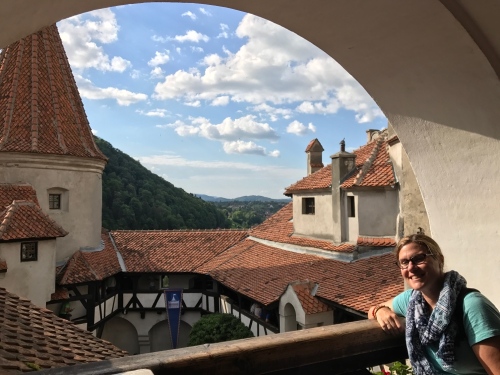

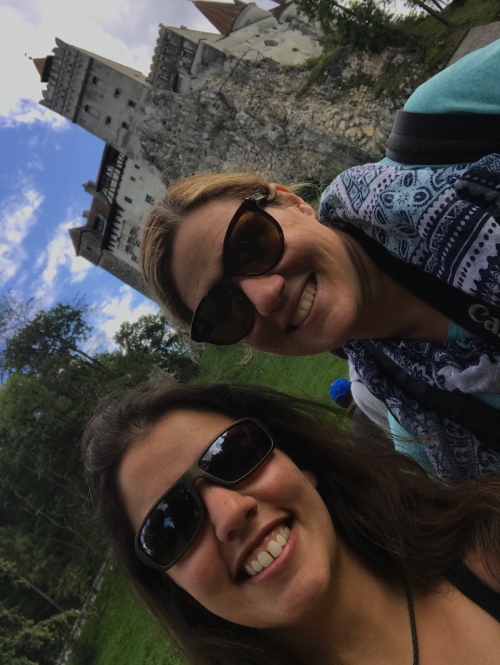
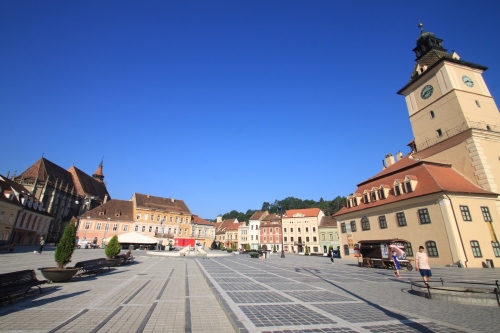
On our second day in Brasov, and in my quest to visit more Dracula sights, we took our little put-put car for a road trip to the medieval fortified town of Sighisoara, where historians agree he was born. On our way, we drove through flowered hills and meadows, and adorable little Saxon villages, each with its own fortified church serving as the center of town. Before arriving in Sighisoara, we decided to take a little detour and visit a small village called Viscri with a population of 450 people. The village’s fortified church dates back to 1185 and has recently been declared a UNESCO World Heritage site; along with the rest of the town. As we drove through dirt roads, we came across a herd of sheep crossing our pathway with the most adorable Shepard dog directing them along the way. As the dirt continued to kick up behind us, we eventually pulled into a small little village that hold’s Europe’s best preserved medieval houses, many of which have been colorfully restored. The church that sits just above the town on a hill serves as the centerpiece for visitors and was our first stop once arriving in Viscri.
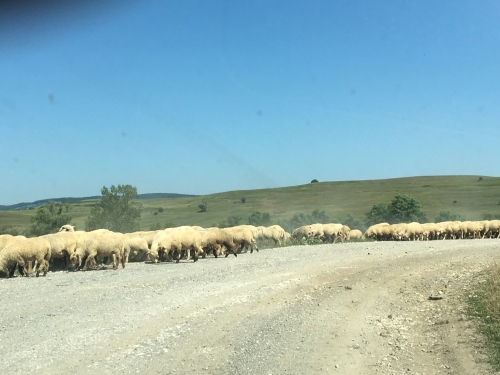


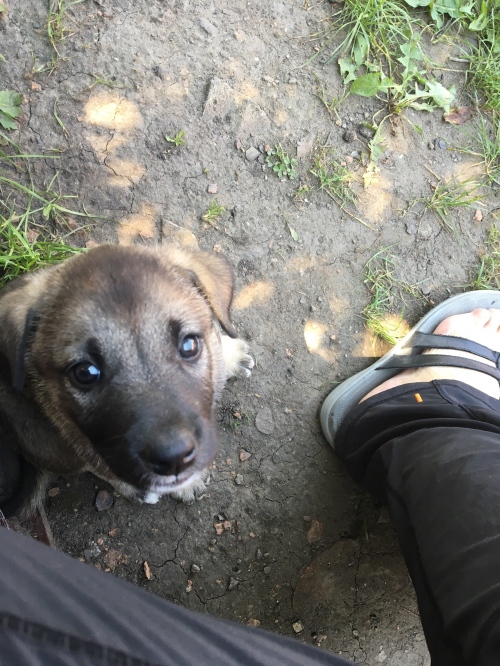



Ok, enough history…back to Dracula.
It was within these walls that Vlad Tepes, aka, Vlad III, aka Vlad the Impaler, aka Dracula was born in 1431. Right off the main square, one finds Casa Dracula, a large yellow building proclaiming to be the exact birthplace of Vlad the Bad. Today, the building serves as a restuarant, which actually suprised us with good food, but there is little historical evidence to determine the exact dwelling Dracula was born in. When we stopped into the Tourist Information center upon entering the walled city, the lady seemed all the less amused at me asking where he was born. We were learning however, that this seemed to be the Romanian way of dealing with people, or at least that was our experience. (To be continued).
Anyway, once we left the very unhelpful help desk, we popped into St. Joseph’s Roman Catholic Church, came across a statue of Vlad the Impaler, walked along the outer streets and visited some of the original towers on the periphery to protect the citadel. The fact that nine of these original towers still exist impressed us greatly, but the highlight for me was definitely visiting Casa Dracula.
With both of us a bit hungry, we decided to pop into Casa Dracula for a little bit of food with a splash of kitsch. In addition to currently serving as a restuarant, the house that Vlad Tepes was born also lets tourists visit the room where he was allegedly born for a small fee. After a quick bite of traditional Romanian polenta with sour cream and cheese, followed by ice cream, I paid my 5 lei to enter the room.





After lunch we headed over to the covered staircase and climbed 172 steps up to the 17th century Lutheran “church on the hill”. Before leaving the citadel, we saved the best for last and paid admission to climb the steps up the clock tower, which dates back to 1280. Hands down the prettiest building inside the citadel, the clock tower has small, moving figurines aligned to the day and week that look down onto the town from above. It also gives you panoramic views of the city in every direction.




That evening, we had dinner in a small tavern that was reommended for its traditional, home-style Romanian food. Here we tried the national drink of Romania, which is essentially plum brandy.

From here, we walked around Brasov a bit, stopping at one of the many bars with outside seating. Sitting there, enjoying a spirit and people watching, the charm of Brasov was omnipresent. That is, until a drunk man came stumbling up to Michelle from behind asking, presumably, for money (we hope). When the waiter shooed him away, we kind of laughed about it, until a few moments later he was back harassing someone else. As Michelle looked over, he pulled his pants down for everyone to see! Perhaps, Dracula got drunk here too.
On our third day in Transylvania, we ventured to the small town of Zarnesti which leads to Piatra Craiului National Park. A few people had recommended doing the blue line trail through the park, as it loops up to the “Cabana Curmatura” then back down to where you can leave your car. We started the hike through a beautiful canyon where we met up with a family from France and their super friendly guide who assured us we were going in the right direction.


When the canyon ended, we split off from the French who were taking a gentler route up to the mountain hut, and we began to ascend into the deep and dark Romanian forest. The Carpathian Mountains are a highlight of visiting Romania because of these fairytale forests, but to be honest, I was a little freaked out at first. In addition to a high concentration of Dracula Kitsch, Romania has the highest percentage of bears in all of Europe because Nicolas Ceausescu made the hunting of them illegal. As a result, there are multiple bear-killings a year, leading us to play loud music as we hiked with the intent of not startling one into attacking us. Once I got past my fear of being mauled to death by a giant Teddy, and when we reached the alpine meadow at the top of the ridge, I began to enjoy myself again.



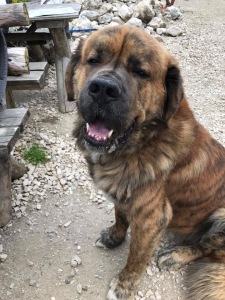
After a great day of hiking in the Carpathian Mountains, we decided the next day we should hire a driver to take us on the Transfagarasan Highway, which connects Transylvania to Wallachia through the Fagaras mountain range. The road, which has been dubbed by the cast of Top Gear as the “greates road in the world”, was built in the 1970s as a way of securing the border between these two regions in Romania should the Soviets attach.
When our guide met us in Brasov I was not too sure the day was going to be a good one. My concern started when he asked us what why we were visitng Romania and after we told him tourism, I added in…”Transylvania is so beautiful” to which he replied “There is more to Romania than Transylvania!” Okay, then…..we’re off to a good start.
The day did get better as we ascended into the mountains were privileged to more and more great views.




At the end of the road is yet another Dracula sight, Poenari Fortress (Castle), known as the “real” Dracula Castle. At the base of the sight, there is a small souvenir stall selling everything from magnets to fake teeth with blood, to miniature castles. Next to the entrance is a Dracula Camping ground, where you can sleep beneath the stars and the fortress that Vlad built as a last minute protection, high on the hill. To get there, one has to climb 1,480 stairs before you reach what Michelle described as a “pile of bricks”. As much of the fortress is not really there, there is little to see, but the surrounding views give you a sense of what it must have been like for Vlad and his family when they were hiding out up here. In pure tourism kitsch, there are two fake bodies “impaled” on the grounds which are the first things you see when you emerge out of the trees into the fort.


Our last day in Romania was a hectic one. We had planned to visit Peles Castle on our way back to Bucharest, but first we needed to get infomration on how we could travel into Bulgaria. Every person, book, or online forum I had consulted gave inconsistent information regarding train times and buses that would cross over the Danube River into Bulgaria. Consequently, before setting off on our southward roadtrip, we stopped off at the train station where the lady at the international ticket office told me there was one train to Bulgaria at noon everyday. When I asked her about buses, she seemed annoyed and shooed me away. Outside, I saw an Information/Tourist Desk and proceeded to ask the lady behind the counter about possible buses from Bucharest to Sofia, but she seemed perplexed that I was speaking English and did not understand. I moved on.
About 2 hours outside of Brasov, we stopped off in the beautiful resort town of Siniai, which sits at the base of Peles Castle. Much nicer and bigger than Bran’s and the “pile of bricks” that is Poenari Castle, Peles Castle served as the summer home of King Carole and the Royal family in the late 19th century. Visiting the castle is much like visiting other palaces throughout Europe where you walk from room to room oohing and aahing at the ornate doors, esoteric collection of paintings, and sheer gaudiness that often is synonymous with royal decor. While inside, we stealthily (not really) hopped on the back of a tour and got a bit of information regarding the history of the castle. I don’t really remember much of what we learned but one thing that is for certain; Dracula did not sleep here!.
Besides, the real oohing and aahing came from outside the castle.
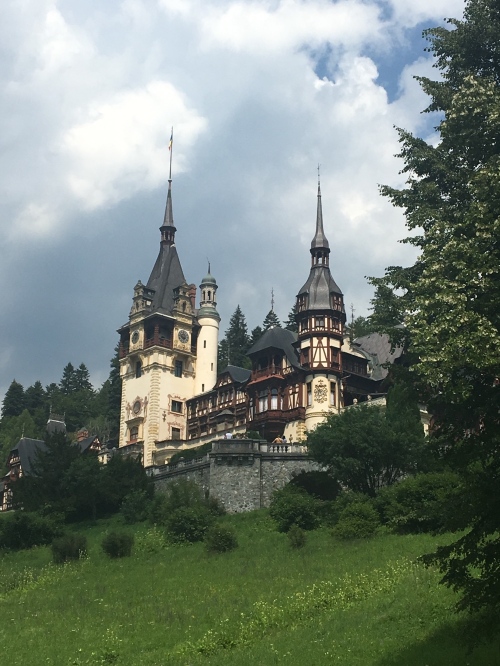

Before leaving Sinaia, we stopped off once again at the Tourist/Information office. Because of my encounter in Brasov where the women spoke and understood no English, my first question to the man behind the counter was “do you speak English” to which he rudely yelled “skip this question!” as if he was annoyed I had asked. He then proceeded to try and find out about trains from Bucharest to Sofia, and told us there was only one….a week! If his information was correct, we would be stuck in the land of Dracula for another six days and to be honest, I was getting rather sick of being yelled at by Romanians.
We frantically drove to the train station in Bucharest where fortunately, our tourist office friend’s information proved to be inaccurate and we bought two tickets for the afternoon train the following day. This meant we had to spend the night in Bucharest which we were hoping to avoid. The city has a certain darkness and seediness to it that although has the potential to be hip, at the moment just gave us the yucks. Fortunatley for us, there was a food truck festival right outside our hostel, unfortunately for us, it was beyond noisy as every bar and nightclub in the area, which is basically every single building, seems to compete for customers by blasting music and adverstising, and well, how should I say?…”shady things”. As “House of Pain” came blaring through our window, I couldn’t leave Romania soon enough.
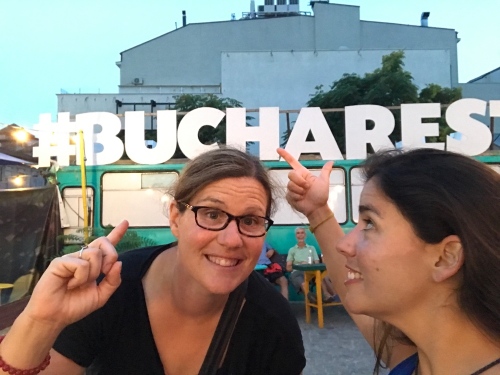
From campy Dracula sights in Translysvania to the seedy nightlife in Bucharest, Romania was not my favorite place, but it was interesting, and oftentimes, beautiful (Bucharest, not withstanding). Anyone who follows my posts knows that for me, it is the people of a place that usually make the biggest impression on me, and more often than not, I am moved by their hospitality and kindness. This was not the case for me in Romania. I’m sure someone who reads this might disagree with me,and I don’t portend to speak knowingly of the entire country, but there seemed to be neither kindness nor hospitatlity from most of the people we interacted with throughout the country. Historically situated between the Austria-Hungary and Ottoman Empires, and continuously being under foreign rule, except for a brief period of the monarchy (seen as the “golden age”) does not make for a happy-go-lucky people. Add in a splash of totalitarian communism for 40 years under the leadership of a bat-shit crazy ruler, and it becomes hard to hold this against them. When the most well known person in your history is a medieval prince who has infamously been turned into a blood-sucking monster via pop culture and memory, it is not surprising the people come across as cold and bitter. I’m sure, just like Vlad III was not really a blood sucking vampire, the Romanian people aren’t really as stand-offish as they seemed. Perhaps underneath their abrupt answers and vacant facial expressions lies a warm and open people…and perhaps Dracula really did sleep here.